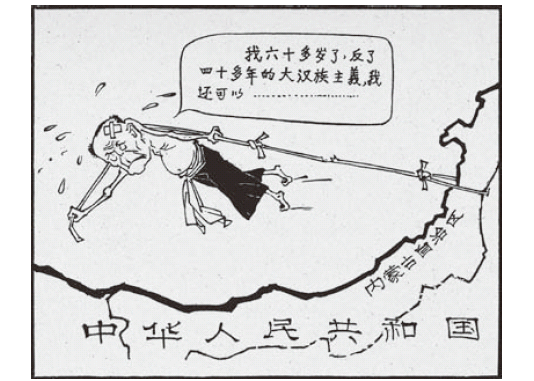[Note: The following is a foreword of a book entitled "Mongolian Genocide during the Cultural Revolution in Inner Mongolia" that was translated from Chinese to Japanese by Dr. Yang Haiying.]

Mongolian Genocide
by
Communist China during the Cultural Revolution in Inner Mongolia
Yang Haiying
This book focuses on the “ethnic genocide against the Mongols”, which broke out in Inner Mongolia during the Great Chinese Cultural Revolution between autumn 1968 and the beginning of 1970. An analysis is made from the perspective of studies of ethnic genocide.
Human beings experienced a large number of genocides in the 20th century including the Holocaust perpetrated by Nazi Germany. In the aftermath of World War II, a resolution was adopted in the general assembly of the United Nations on Dec. 9, 1948, which was titled the “Convention on the Prevention and Punishment of the Crime of Genocide”. This important development demonstrates a strong resolution shared in the international community that such atrocities should never be repeated in human history.
The Convention defines “genocide” as follows:
. . .genocide means any of the following acts committed with intent to destroy, in whole or in part, a national, ethnical, racial or religious group, as such:
(a) Killing members of the group;
(b) Causing serious bodily or mental harm to members of the group;
(c) Deliberately inflicting on the group conditions of life calculated to bring about its physical destruction in whole or in part;
(d) Imposing measures intended to prevent births within the group;
(e) Forcibly transferring children of the group to another group.
Despite the adoption of this UN resolution, subsequent decades witnessed the outbreak of many acts of genocide at various places across the world, rather than its elimination. This book tries to elucidate how genocide relates itself to the fundamental rules of modern society, particularly the relations between nation states and ethnic autonomy. The analysis is based on the theory of “nation state genocide”, which has been held by quite a few experts for some time. On the one hand, there were high aspirations for the establishment of unified China as a nation state. On the other, strong opposition was launched by Mongols, who attempted to construct another nation state of their own. Exposed to such a striking conflict of interest, Mongols became the victims of genocide committed by China.
China consists of 56 ethnic groups. Those Chinese anthropologists favoured and patronised by the establishment have peppered Chinese history with self-pride and self-commendations. They claim that “China has been a unified multi-ethnic nation state since ancient times, the centrepiece of which has been the Han(Chinese).” Propaganda has taught that the ethnic minorities in China have been taken good care of by “the Han(Chinese), the big brother” , and have been leading happy lives as members of the “giant socialist multiethnic family bonded together by the spirit of unity”. This sort of self-commendation has obscured the historical realities of genocide, which has been perpetrated against various ethnic minorities in China.
Historically speaking, those who propound socialism have upheld the “extinction of ethnic groups” as part of their ideal, dedicating themselves to the fight for such extinction. China is no exception. The Chinese Cultural Revolution was begun by the Chinese Communist Party (CCP) in 1966. In order to achieve their ideal, the “extinction of ethnic groups”, the CCP exercised violence, in which they were highly skilled. A typical example was the genocide committed in the Inner Mongolia Autonomous Region (IMAR) against members of the Inner Mongolia People's Party (IMPP) and other organisations, who were primarily Mongols. The he Chinese establishment described this incident as a “movement to identify and purge away (wasu) the members of the IMPP”
This political party, the IMPP, was founded in 1925 for the purposes of the independence and autonomy of Inner Mongolia. It was formed based on the ruling party of the People's Republic of Mongolia, the Mongolian People's Revolutionary Party (MPRP), and significant support and encouragement was provided by the Comintern. In subsequent years, when Japan advanced its military power over the Chinese mainland, most members of the IMPP became government officials in the Manchurian Empire ruled by Japan. On the defeat of Japan at the end of World War II, the IMPP resumed its political activities, aspiring to achieve integration with the People’s Republic of Mongolia. However, this venture was suppressed by the CCP and fell through. The political manoeuvre to suppress Mongol independence was headed by a Mongol called Ulaanhu, who was patronised by the CCP. When the IMPP was forced to dissolve in 1947, some members opted to join the CCP. Ulaanhu was highly praised for his contribution and regarded as a "dedicated loyal friend”. He long continued in power as the supreme ruler of Inner Mongolia from 1947.
The political landscape of Inner Mongolia was completely turned over in 1966, however when, out of the blue, Mao Ze-dong, Chairman of the Central Committee of the CCP, accused the IMPP headed by Ulaanhu of persistently refusing to dissolve since 1947, and that it had continued an underground “political movement aiming to divide the motherland, China”. With this accusation, the genocide against Mongols started, with the aim of rooting out the Mongolian elite. A conservative estimate by the Chinese government states that 16,222 Mongols lost their lives. An independent study reports, however, that a further 50,000 Mongols were victims of the Revolution.
The genocide against Mongols in the IMAR was triggered against the background of confrontation between two forces, “one for the unification of a nation state and the other against it”. This incident itself reveals the autocratic and violent nature of policies implemented by the socialist government of China upon ethnic minorities.







